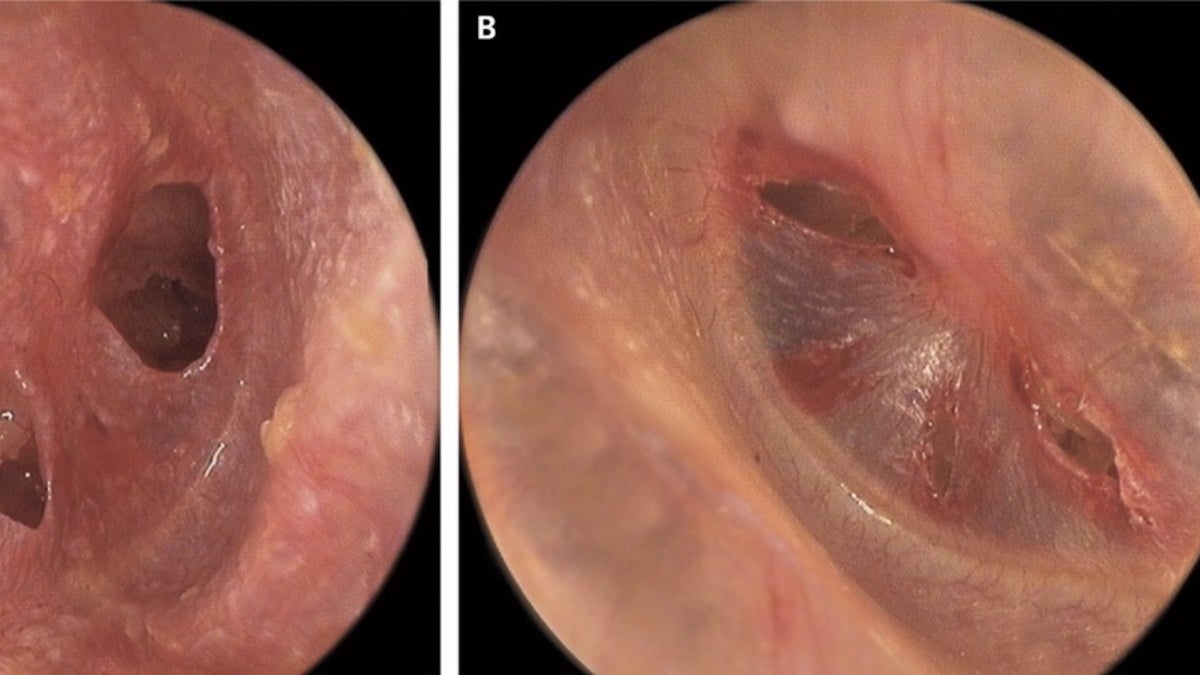
These images show the man's ruptured eardrums. The image on the left shows the man's right eardrum, and the image on the right shows his left eardrum. (Courtesy of The New England Journal of Medicine ©2017)
Celebratory fireworks at a wedding led to the rupturing of both of a man’s eardrums, according to a brief report of the man's case.
The 30-year-old man went to the emergency room in Switzerland after an explosion from the fireworks accidentally went off close to where he was standing, according to the report, published today (May 10) in The New England Journal of Medicine .
The eardrum, which is also called the tympanic membrane, is a thin membrane inside the ear canal. When sound waves hit the eardrum, it vibrates. However, very loud noises , which produce very large sound waves, can cause the eardrum to tear, according to the Mayo Clinic .
Eardrum ruptures are not uncommon, said Dr. Patrick Dubach, an ear, nose and throat doctor at Solothurn Hospital in Switzerland who treated the man. Dubach said he sees a ruptured eardrum about once every two months, but in most cases, fireworks are not the cause. A more common source of the injury is when a person inserts a Q-tip too far into his or her ear, Dubach said.
When the man arrived at the hospital, he was experiencing hearing loss and a ringing in his ears, a problem known as tinnitus, according to the report. The doctors tested the man's hearing and found that he had experienced mild "conductive" hearing loss and moderate "sensorineural" hearing loss, according to the report.
Conductive hearing loss occurs when the structures of the ear, including the eardrum, are damaged, according to the Hearing Loss Association of America (HLAA). In the man's case, his conductive hearing loss was due to the rupturing of his eardrums, Dubach told Live Science.
Sensorineural hearing loss, on the other hand, refers to hearing loss caused by damage to either the tiny cells, called hair cells , found within in the inner ear or to the nerves that are related to hearing, the HLAA says. Acoustic trauma, or very loud noise, is one of the things that can damage the cells of the inner ear, Dubach said.
In addition to hearing loss, ruptured eardrums can lead to other problems, Dubach said. For example, a ruptured eardrum can open the ear up to bacterial infections , Dubach said. This is because the eardrum doesn't only play a role in hearing; it also acts as a barrier to keep bacteria out.
It's possible for cysts, called cholesteatomas, to form in the ear of someone with a ruptured eardrum, too, Dubach said. These cysts provide a friendly breeding ground for bacteria and contain proteins that can damage the bones in the ear, according to the Mayo Clinic.
Ruptured eardrums can also lead to vertigo and balance problems, Dubach added.
In most cases, a ruptured eardrum will heal in a few weeks on its own, according the Mayo Clinic. But sometimes, a short medical procedure or surgery is needed, the Mayo Clinic says.
In the man's case, the doctors repaired his eardrums using a procedure called patching, according to the report. During the procedure, doctors seal the hole in the eardrum with a small patch, according to the Mayo Clinic.
Three months later, the man's eardrums had healed, and his hearing had returned to the normal, the doctors wrote.
Originally published on Live Science .
